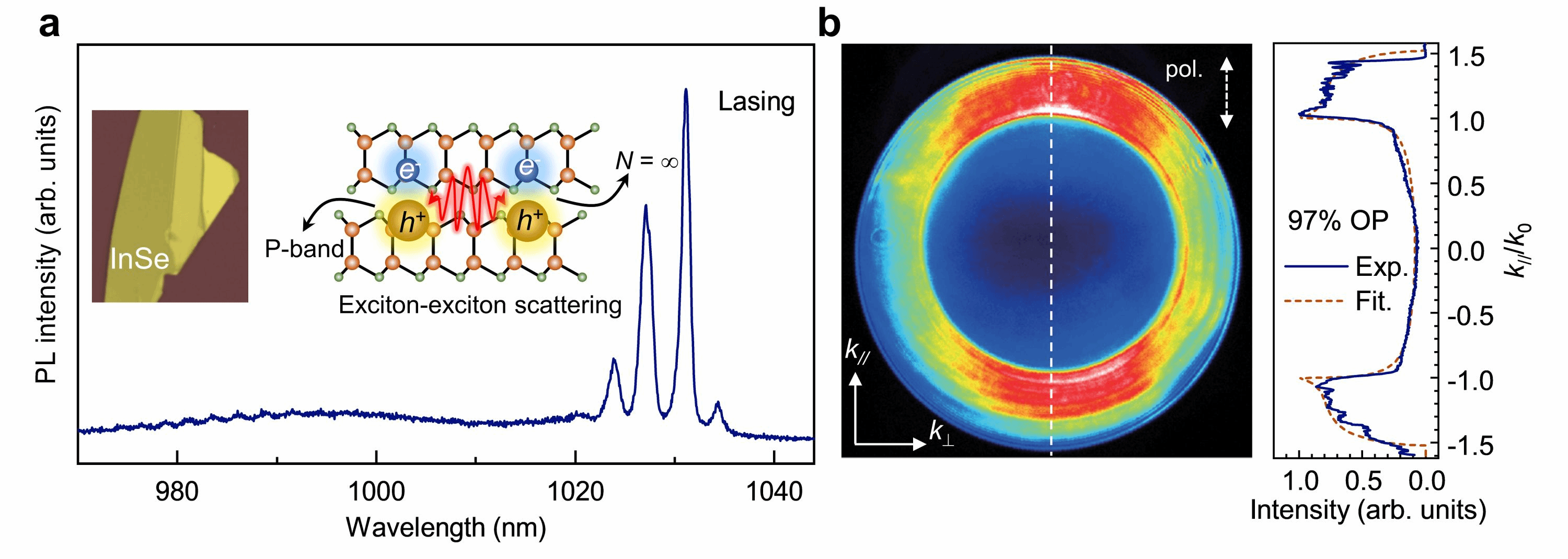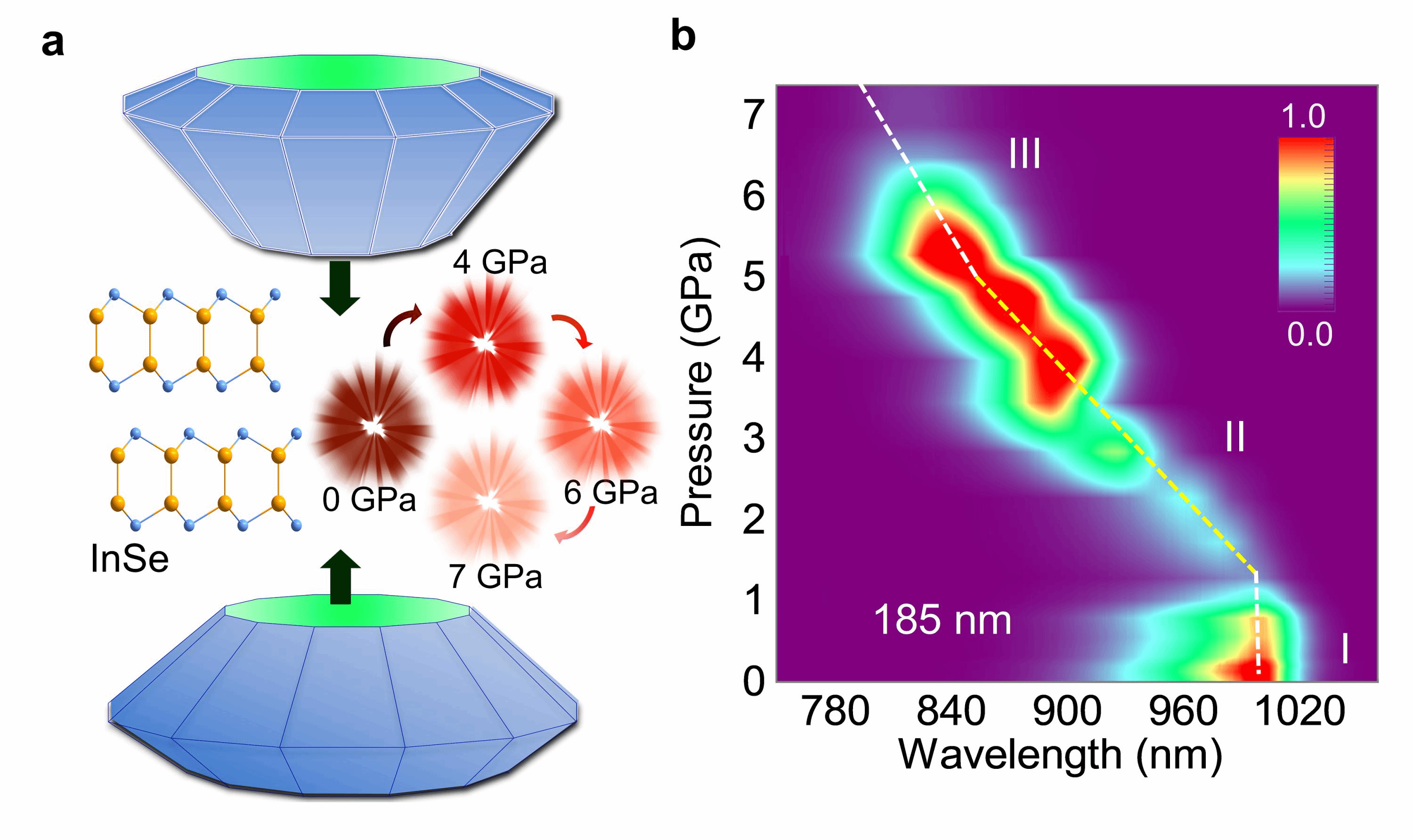Recently, 2D layered semiconductors have emerged as promising gain materials for on-chip lasers and amplifiers owing to their outstanding chemical and physical properties, such as dangling-bond-free surfaces, atomically thin structures, rich exciton and valley features, and strongspatial confinements. The established 2D lasers have the advantages of ultrasmall volume, low threshold, and easy of emission tunability. However, these lasers require complicated and expensive microfabrication processes and mainly operate in the red spectral range, which greatly restricts their commercial applications. InSe, a van der Waals layered semiconductor material, has a direct bandgap when the thickness is over 6 nm, and can act as both a potential gain medium and cavity without requiring an external optical cavity. It is also compatible with top-down lithography processes. Thus, InSe has a unique attraction for the development of coherent photon sources. In addition, InSe exhibits superplastic deformability, allowing the change of lattice structure, atomic spacing, and interlayer distance by applying external pressure to modulate the electronic band gap and develop ultra-wide spectrum multicolor microlasing.
Based on the above background, Prof. Qing Zhang's group, from the School of Materials Science and Engineering at Peking University, investigated the near-infrared lasing behavior of InSe at room temperature. They revealed the gain mechanism induced by exciton-exciton scattering and explored the hydrostatic-pressure-engineered near-infrared lasing properties. Related research results have been published inACS Nano2022, 16, 1477-1485 andNano Lett.2022, 22, 3840-3847, entitled “Room-temperature Near-infrared Excitonic Lasing from Mechanically Exfoliated InSe Microflake” and “Engineering Near-Infrared Light Emission in Mechanically Exfoliated InSe Platelets through Hydrostatic Pressure for Multicolor Microlasing”, respectively. The School of Materials Science and Engineering at Peking University is the first organization.
Prof. Qing Zhang's group first demonstrated the room-temperature near-infrared lasing of mechanically exfoliated InSe microflakes (ACS Nano2022, 16, 1477-1485). They found that the net optical gain was as high as 1029cm−1. And they revealed the exciton-exciton scatteringinduced lasing mechanism by studying temperature- and power-dependent photoluminescence (PL) spectroscopy. In addition, they fabricated microdisk lasers via laser printing technique with lasing threshold reduced by more than 60%. These results provide a new idea for the development of low-energy consumption on-chip near-infrared laser sources in the future. Ph. D. candidate Chun Li is the first author of this work. This work was also assisted by Prof. Yunan Gao from Peking University, Prof. Qiang Cao from Wuhan University, and Prof. Zhongming Wei and Prof. Jun Zhang from the Institute of Semiconductors of the Chinese Academy of Sciences.

(a) Lasing emission spectra of mechanically exfoliated InSe microflake. The inset is the optical image and schematic of exciton-exciton scattering of the InSe microflake; (b) The normalizedk-space emission pattern of the InSe microflake. The corresponding intensity curve at the white dashed line displays that the out-of-planedipole contribution reaches 97%.
Further, Prof.Qing Zhang's group cooperated with Prof. Zhongming Wei from the Institute of Semiconductors of the Chinese Academy of Sciences and Prof. Min Wang from Southwest University, investigated hydrostatic-pressure-engineered spontaneous emission and lasing properties of InSe platelets by using diamond anvil cell technique (Nano Lett.2022, 22, 3840-3847). They discovered anultrabroad spontaneous emission tunability of over 180 nm and a lasing tunabilityof over 110 nm. Based on the first-principle calculations, they revealed that the pressure-induced wavelength blueshift of InSe is mainly attributed to the compression of the soft intralayer In−Se bonds under high pressure. Moreover, they found that the evolution of spontaneous emission intensity of InSe under hydrostatic pressure can be divided into three stages. When the pressure is <1.3 GPa, the PL intensity decreases dueto the pressure-induced lattice distortion. When the pressure is in the range of 1.3−4.7 GPa, the exciton binding energy increases and the PL intensity gradually recovers. When the pressure exceeds 4.7 GPa, the PL intensity gradually decreases to quenching due to the direct–indirect band gap transition. This work provides a new idea for near-infrared wavelength tunable optics and optoelectronic devices. Ph. D. candidate Liyun Zhao and Yin Liang are co-first authors of this work. This work was also supported by Prof. Jun Zhang from the Institute of Semiconductors of the Chinese Academy of Sciences, and Prof. Xinfeng Liu from the National Center for Nanoscience and Technology.

(a)Schematic of hydrostatic-pressure-engineered emission of InSe platelet; (b) 2D pseudocolor PL spectra of an individual InSe platelet as a function of pressure.
This series of work was supported by the National Natural Science Foundation of China, the National Key Research and Development Program of China, and theNatural Science Foundation of Beijing Municipality.